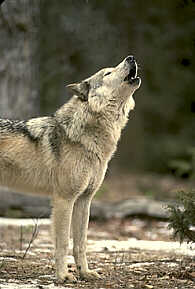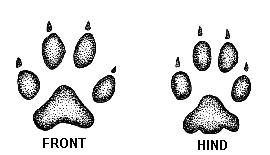
Grey
Wolf
Canis lupus or Timberwolf
Description
- Generally the grey wolf is a grizzled grey but
colour varies from white to black. The ears are erect
and the tail is bushy and black tipped. The male is
larger than the female and average weight is 55-130
pounds.
Distribution
- The grey wolf, also known as the timber wolf, prefers
the open tundra and forests of British Columbia. Although
they once inhabited most of North America, now distribution
occurs in only Alaska, Canada, and parts of the U.S.A.
Human fear, superstition, and outright hatred of this
animal decreased its population drastically and eradicated
it from 50% of its former range.
Biology
- The wolf is a very social animal who mates for life
and lives in packs of 2-15. The strongest male is usually
the pack leader; all members of the pack care for the
young which helps unite the pack. An average of 7 pups
are born to each female in April-June. Usually hunting
at night, they feed primarily on large mammals by chasing
down their victims either slashing tendons or driving
it back to waiting pack members. Even though they kill
only to survive, studies show that wolves play a key
role in drastically decreasing the number of ungulates,
sometimes beyond the rate of replacement, in any given
area. The wolf's only important predator is man.

Tracks
- The grey wolf generally travels in packs. During the
snowy winter months they tend to follow the trail made
by the leader to conserve energy. The front foot is
larger than the rear and the toes are often splayed
particularily in soft ground. The front foot track is
rounded with four toes with the claws evident and the
heel pad having a inverted V-shape, whereas the rear
is slightly more oval with a triangular shaped pad.
Straddle: 16 -18 cm (6.4 - 7.2 in)
Stride: 40 - 46 cm (16 - 18.4 in)
Track: 11 cm (4.4 in) long / 10 cm (4 in) wide


